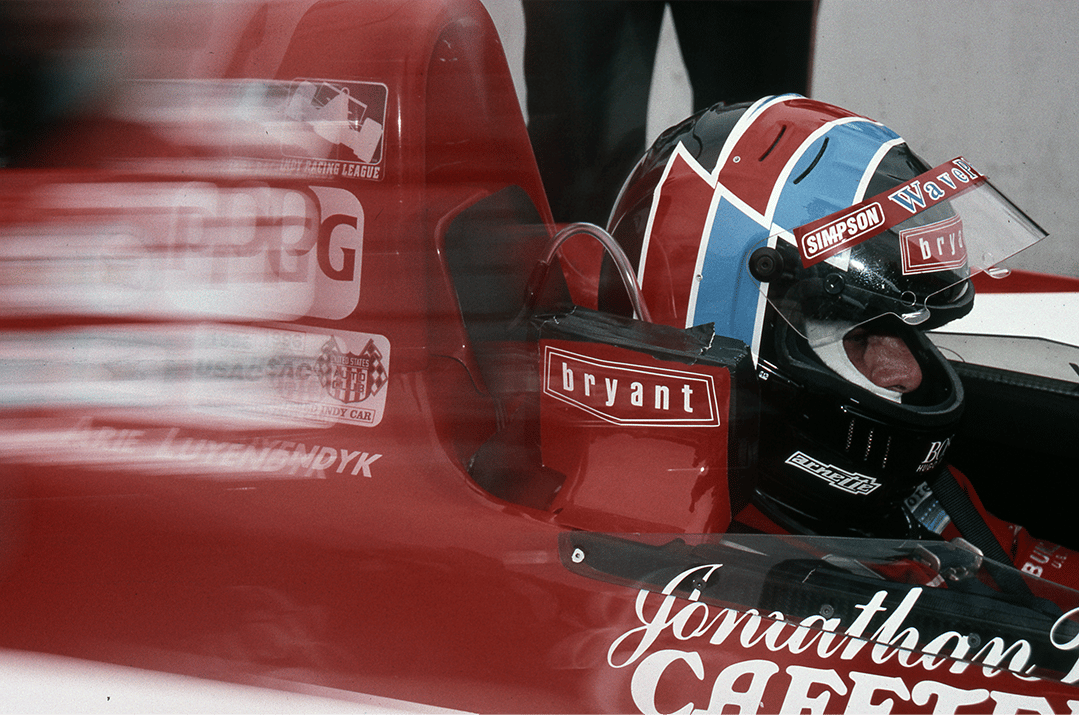
Arie Luyendyk is surprising in assessing the record-setting qualifying run he delivered 25 years ago at Indianapolis Motor Speedway. Comparatively speaking, he says it wasn’t all that difficult.
In 1996, the year Luyendyk set the track’s one- and four-lap speed averages of 237.498 mph and 236.986 mph, respectively, and nearly reached 240 mph in practice, he said he felt more comfortable driving at those speeds than when he went significantly slower in years prior and following.
– Arie Luyendyk



The record-setting qualifying run overshadows that Luyendyk didn’t start on the pole (Tony Stewart did after Scott Brayton lost his life in a Turn 2 crash in practice).
Luyendyk’s backup car, which he used on Pole Day, had been hurriedly assembled after a late vapor lock developed in the engine of his primary car, and the backup was disqualified after his run for being too light. That forced Luyendyk to be a second-day qualifier, but it also gave Treadway Racing time to revert to the primary car and make what became a history-making qualifying run.
Even by today’s standards, Luyendyk’s line reflects the effortless Sunday afternoon drive it was.
Luyendyk, the Dutch road racer, worked up to speed on ovals by completing a 200-lap test – complete with pit stops – at the Milwaukee Mile in the fall of 1984. An added benefit to a smooth transition to IMS was completing Indy’s Rookie Orientation Program, which required him to work up to speed in a controlled manner.
After qualifying 20th, Luyendyk steadily advanced through the field, finishing seventh to earn Rookie of the Year honors in 1985. He described it as a 200-lap, mind-over-matter exercise.
Luyendyk couldn’t have imagined that being possible when he saw IMS for the first time in 1981. Like most newbies to the Racing Capital of the World, Luyendyk and his wife, Mieke, rode one of the IMS Museum’s tour buses. He remembers his reaction being immediate and sure.
Indy’s oval initially looked spacious with flowing corners. But from the windows of that bus, the long straightaways seemed confined and daunting.
In 1984, Luyendyk returned to IMS to watch his first Indianapolis 500 as a guest of Provimi Veal, a sponsor of Derek Daly’s car at Bettenhausen Motorsports. Luyendyk still wasn’t sure what to make of intense oval-track racing; he chose to concentrate on how much he enjoyed high-speed corners in European road racing. The difference? Indy’s fast four corners were lined with intimidating walls.

– Arie Luyendyk




– Arie Luyendyk

People fondly recall Luyendyk’s first Indianapolis 500 victory, but many forget it was the first win of his INDYCAR career. He had often drove like a race-winning driver in those first 75 races, but he had only three top-three finishes. He remembers being confident on that May morning in 1990.
Winning Indy verified Luyendyk’s status because he not only beat the best drivers of that era – there were 11 former or future “500” winners in that race – but he did so convincingly.
The margin of victory was nearly 10.878 seconds, and the five drivers to follow him across the finish line either were legends of the sport or soon would be. Those drivers – Bobby Rahal, Emerson Fittipaldi, Al Unser Jr., Rick Mears and A.J. Foyt – combined to win Indy 13 times with 16 season championships (plus Fittipaldi’s two Formula One titles).



Ironically, seeing the white flag almost was part of losing the 1997 race to teammate Scott Goodyear.
“When I was really paying attention to the starter’s stand, I saw not only the white flag, but I saw – to my surprise – the green flag,” he said. “I came on the radio (to Treadway Racing) and said, ‘What the heck is going on?’”
Race officials had determined that the debris which had necessitated the yellow had been cleared in time for a one-lap shootout.
“I was expecting to ride around and finish under yellow,” Luyendyk said. “The lights had not gone out on the Pace Car, although the Pace Car did go into the pits. So, I was not ready for it; I was in the wrong gear. I really thought, ‘I’m going to be passed left and right by everybody,’ but luckily (the restart) was a surprise to everybody.”
With changing equipment, circumstances and weather conditions, each “500” presents its own challenges. That’s why Luyendyk is particularly proud of his 1997 win.
With the engine and gearbox being heavier in the year of the Indy Racing League’s first equipment package, weight distribution was a challenge for competitors to solve. Luyendyk credited his veteran engineer, Tim Wardrop, for the setup that was ideal on Race Day, and he said he did some of his best driving.
– Arie Luyendyk

Perhaps as significant was the fact Luyendyk was part of a revolution, the first European driver since Graham Hill in 1966 to win the “500,” and Luyendyk was only the second foreign-born driver to win the race in 21 years.
In motorsports, a white flag waves to signify a driver’s final lap. But Luyendyk never saw it that year. Why? He was focused on Fittipaldi’s charging car as the defending winner attempted to unlap himself.




It also is worth noting that only nine drivers in Indy history have won as many poles as Luyendyk, and only four of those have more race wins at the Speedway.
Today, Luyendyk serves as a race steward for the NTT INDYCAR SERIES. Yes, he and fellow former driver Max Papis make decisions to penalize drivers, when necessary, but the scope of their responsibilities extend well beyond that. He also coaches drivers, such as race winners Ryan Briscoe, Mike Conway and Charlie Kimball, to name a few. Now, his sights are set on 2020 NTT INDYCAR SERIES Rookie of the Year Rinus VeeKay.

– Arie Luyendyk






ARIE LUYENDYK – 25 YEARS

Arie Luyendyk is surprising in assessing the record-setting qualifying run he delivered 25 years ago at Indianapolis Motor Speedway. Comparatively speaking, he says it wasn’t all that difficult.
In 1996, the year Luyendyk set the track’s one- and four-lap speed averages of 237.498 mph and 236.986 mph, respectively, and nearly reached 240 mph in practice, he said he felt more comfortable driving at those speeds than when he went significantly slower in years prior and following.
– Arie Luyendyk

The record-setting qualifying run overshadows that Luyendyk didn’t start on the pole (Tony Stewart did after Scott Brayton lost his life in a Turn 2 crash in practice).
Luyendyk’s backup car, which he used on Pole Day, had been hurriedly assembled after a late vapor lock developed in the engine of his primary car, and the backup was disqualified after his run for being too light. That forced Luyendyk to be a second-day qualifier, but it also gave Treadway Racing time to revert to the primary car and make what became a history-making qualifying run.
Even by today’s standards, Luyendyk’s line reflects the effortless Sunday afternoon drive it was.


– Arie Luyendyk




Luyendyk couldn’t have imagined that being possible when he saw IMS for the first time in 1981. Like most newbies to the Racing Capital of the World, Luyendyk and his wife, Mieke, rode one of the IMS Museum’s tour buses. He remembers his reaction being immediate and sure.
Indy’s oval initially looked spacious with flowing corners. But from the windows of that bus, the long straightaways seemed confined and daunting.
In 1984, Luyendyk returned to IMS to watch his first Indianapolis 500 as a guest of Provimi Veal, a sponsor of Derek Daly’s car at Bettenhausen Motorsports. Luyendyk still wasn’t sure what to make of intense oval-track racing; he chose to concentrate on how much he enjoyed high-speed corners in European road racing. The difference? Indy’s fast four corners were lined with intimidating walls.
Luyendyk, the Dutch road racer, worked up to speed on ovals by completing a 200-lap test – complete with pit stops – at the Milwaukee Mile in the fall of 1984. An added benefit to a smooth transition to IMS was completing Indy’s Rookie Orientation Program, which required him to work up to speed in a controlled manner.
After qualifying 20th, Luyendyk steadily advanced through the field, finishing seventh to earn Rookie of the Year honors in 1985. He described it as a 200-lap, mind-over-matter exercise.
– Arie Luyendyk


People fondly recall Luyendyk’s first Indianapolis 500 victory, but many forget it was the first win of his INDYCAR career. He had often drove like a race-winning driver in those first 75 races, but he had only three top-three finishes. He remembers being confident on that May morning in 1990.
Winning Indy verified Luyendyk’s status because he not only beat the best drivers of that era – there were 11 former or future “500” winners in that race – but he did so convincingly.
The margin of victory was nearly 10.878 seconds, and the five drivers to follow him across the finish line either were legends of the sport or soon would be. Those drivers – Bobby Rahal, Emerson Fittipaldi, Al Unser Jr., Rick Mears and A.J. Foyt – combined to win Indy 13 times with 16 season championships (plus Fittipaldi’s two Formula One titles).
Perhaps as significant was the fact Luyendyk was part of a revolution, the first European driver since Graham Hill in 1966 to win the “500,” and Luyendyk was only the second foreign-born driver to win the race in 21 years.
In motorsports, a white flag waves to signify a driver’s final lap. But Luyendyk never saw it that year. Why? He was focused on Fittipaldi’s charging car as the defending winner attempted to unlap himself.


–Arie Luyendyk


Ironically, seeing the white flag almost was part of losing the 1997 race to teammate Scott Goodyear.
“When I was really paying attention to the starter’s stand, I saw not only the white flag, but I saw – to my surprise – the green flag,” he said. “I came on the radio (to Treadway Racing) and said, ‘What the heck is going on?’”
Race officials had determined that the debris which had necessitated the yellow had been cleared in time for a one-lap shootout.
“I was expecting to ride around and finish under yellow,” Luyendyk said. “The lights had not gone out on the Pace Car, although the Pace Car did go into the pits. So, I was not ready for it; I was in the wrong gear. I really thought, ‘I’m going to be passed left and right by everybody,’ but luckily (the restart) was a surprise to everybody.”
With changing equipment, circumstances and weather conditions, each “500” presents its own challenges. That’s why Luyendyk is particularly proud of his 1997 win.
With the engine and gearbox being heavier in the year of the Indy Racing League’s first equipment package, weight distribution was a challenge for competitors to solve. Luyendyk credited his veteran engineer, Tim Wardrop, for the setup that was ideal on Race Day, and he said he did some of his best driving.

–Arie Luyendyk


It also is worth noting that only nine drivers in Indy history have won as many poles as Luyendyk, and only four of those have more race wins at the Speedway.
Today, Luyendyk serves as a race steward for the NTT INDYCAR SERIES. Yes, he and fellow former driver Max Papis make decisions to penalize drivers, when necessary, but the scope of their responsibilities extend well beyond that. He also coaches drivers, such as race winners Ryan Briscoe, Mike Conway and Charlie Kimball, to name a few. Now, his sights are set on 2020 NTT INDYCAR SERIES Rookie of the Year Rinus VeeKay.





WHERE TRADITION NEVER STOPS



HELIO CASTRONEVES – 20 YEARS
